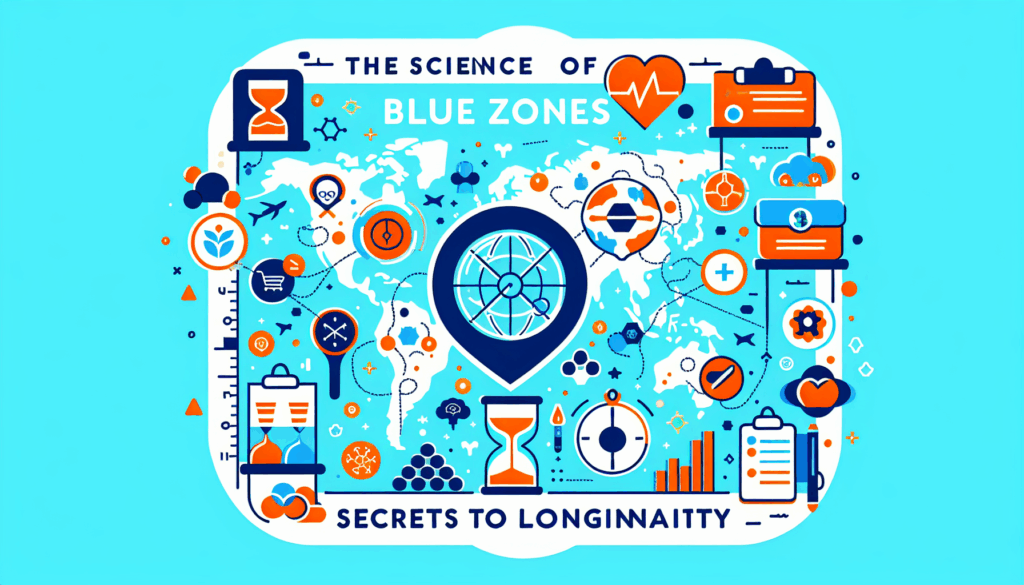Introduction to Blue Zones
Blue Zones are regions of the world where people have been found to live significantly longer and healthier lives compared to the global average. These areas are characterized by a higher percentage of centenarians—individuals aged 100 years or older—and a lower incidence of chronic diseases. Coined by Dan Buettner, a National Geographic Fellow, the term “Blue Zones” refers to five specific regions: Ikaria (Greece), Sardinia (Italy), Okinawa (Japan), Loma Linda (California, USA), and Nicoya Peninsula (Costa Rica). This blog explores the science behind these extraordinary places and the lifestyle habits that contribute to longevity.

The Key Factors of Longevity
Researchers have identified several commonalities among the Blue Zones that contribute to the remarkable longevity of their residents. Here are the key factors:
1. Dietary Patterns
– Plant-Based Nutrition: Residents of Blue Zones primarily consume a plant-based diet rich in vegetables, fruits, whole grains, and legumes. Meat is eaten sparingly, and processed foods are largely absent.
– Moderation: People in these regions practice moderation in their eating habits. They often consume smaller portions and follow the principle of “Hara Hachi Bu” in Okinawa, which means eating until they are 80% full.
– Natural Ingredients: The diets are often rich in antioxidants and omega-3 fatty acids, found in foods like nuts, fish, and olive oil. For instance, the Sardinian diet includes a variety of beans, whole grains, and a moderate intake of red wine.
2. Physical Activity
– Natural Movement: Instead of structured exercise routines, residents engage in regular physical activity as part of their daily lives. This includes walking, gardening, and manual labor, all of which contribute to cardiovascular health and overall well-being.
– Active Lifestyle: In Ikaria, for example, the hilly terrain encourages inhabitants to walk more, while in Sardinia, many people maintain an active lifestyle through farming and traditional crafts.
3. Social Connections
– Strong Relationships: A sense of community and strong social networks play a crucial role in longevity. People in Blue Zones prioritize family and friendships, often living in multi-generational households.
– Supportive Environments: Social engagement reduces stress and creates a support system that promotes mental health. In Loma Linda, the Seventh-day Adventist community encourages social gatherings and activities that foster relationships.
4. Purpose and Outlook on Life
– Sense of Purpose: Having a clear sense of purpose, known as “Ikigai” in Okinawa, is linked to longevity. Residents often have a reason to get up in the morning, whether it’s taking care of family, engaging in work, or contributing to their community.
– Positive Attitude: A positive outlook on life and resilience in the face of challenges are common traits among centenarians. They tend to cope with stress effectively and maintain a hopeful perspective on life.
5. Stress Management
– Relaxation Techniques: People in Blue Zones have established rituals and routines to manage stress effectively. This can include taking time for relaxation, enjoying nature, or participating in spiritual practices.
– Daily Downtime: For instance, in Nicoya, it’s common for people to take a midday siesta, which helps them recharge and reduce stress levels.
6. Spirituality
– Faith and Belonging: Many Blue Zone inhabitants are part of faith-based communities that provide a sense of belonging and support. Spirituality has been linked to lower levels of anxiety and depression, contributing to overall health.
– Rituals and Traditions: Engaging in religious or cultural rituals fosters a connection to heritage and community, which can enhance emotional well-being.
The Science Behind Blue Zones
Research into the lifestyles of Blue Zone populations indicates that their longevity is not a result of genetics alone but a combination of lifestyle factors that work synergistically. Studies have shown that:
– Genetic Influences: While genetics play a role, only about 20-30% of longevity is attributed to hereditary factors. The remaining 70-80% is influenced by lifestyle choices and environmental factors.
– Chronic Disease Prevention: The habits of Blue Zone residents significantly reduce the risk of chronic diseases such as heart disease, diabetes, and cancer. Their lifestyle choices promote healthy aging and longevity.
– Epidemiological Evidence: Researchers have conducted epidemiological studies that demonstrate the correlation between the lifestyles of Blue Zone inhabitants and their health outcomes. This evidence supports the idea that lifestyle modifications can lead to improved health and increased longevity.
Conclusion: Lessons from Blue Zones
The secrets of longevity found in Blue Zones offer valuable lessons for anyone seeking to lead a healthier and longer life. By adopting a plant-based diet, engaging in regular physical activity, nurturing social connections, finding purpose, managing stress, and embracing spirituality, we can enhance our well-being and potentially extend our lifespan.
Incorporating these principles into our daily lives may not guarantee reaching 100 years, but they can certainly lead to a healthier, more fulfilling life. As we learn from the wisdom of Blue Zones, the journey toward longevity is as much about the quality of life as it is about the quantity of years lived.
By embracing these lifestyle changes, we can create our own paths to a healthier, happier existence, no matter where we live.
AI-Assisted Content Disclaimer
This article was created with AI assistance and reviewed by a human for accuracy and clarity.


Leave a Reply